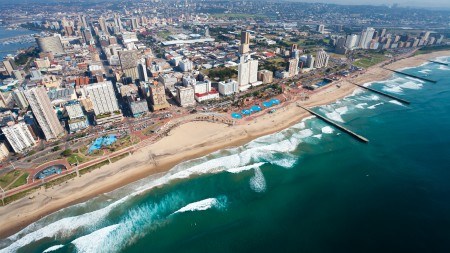What makes for a successful and sustainable urban environment in today’s current climate, and how successful these are in SA.
Home owner needs from their urban environments are often guided by technology.
South African cities are impacted by an ageing infrastructure environment where resources are under duress due largely to urbanisation and population growth. In this context we asked Adrie Fourie, Senior Environmentally Sustainable Design Consultant at Aurecon, what makes for a successful and sustainable urban environment in today’s current climate?
“The South African urban environment is also under pressure from climate change,” says Fourie. “Cities or spaces that are able to respond to such change and address the challenges will be the spaces that thrive”.
In her usage of the word “thrive” Fourie is not just referring to ‘green’ or sustainable practices but also how technology changes the operational aspects of a city or town and thereby making the entire environment the best it can be for its residents and visitors. But again this requires an understanding of the current context.
Wi-fi may be a catalyst
Let’s look briefly at wi-fi for example. South Africa is a developing nation, as defined by its BRICS membership (along with Brazil, China, Russia, and India) and similar to major cities in these countries, for example Sao Paulo, Beijing, Moscow, and Delhi, some SA towns offer free wifi but to a lesser extent than our international counterparts.
Free high-speed wi-fi exists on Sao Paulo’s underground Metro, and in Delhi 11,000 free wi-fi hotspots offer 15 GB data per month which is similar to the amount of data which 11,000 users currently access monthly through the Project Isizwe in the City of Tshwane. In the City of Cape Town there are more than 100 public buildings providing free wifi providing registered users with 100MB per day.
Green spaces
Wi-fi aside, we have to consider the demand for SA cities to move toward greener development approaches, and more sustainable interventions in terms of water and energy consumption. In so doing it is essential there is a collaborative approach to working with governing bodies and developers to create an environment where people and businesses can similarly develop. Fourie expands: “There are urban projects or pockets of brilliance in our towns, but the SA urban environment is constrained by infrastructure development issues, where nodes under the jurisdiction of a single entity might be competing for investment or budgets for maintenance.”
‘Nodes’ in urban design refers to centralised areas where there is activity combined with infrastructure to support it, be that residential or commercial buildings, and particularly those centers that provide public transport options.
“This is what our residents need and indeed are demanding; nodes that are more financially and environmentally sustainable, more connected - via technology or transport access, and that are appropriately managed”.
Fourie says it is hard to comprehensively list all the elements that would define a successful urban environment as the context and needs of the specific community it serves will differ, but for her the baseline is that residents must be provided with the opportunities to thrive. “Access to basic services seems mundane and obvious but it really is the most important building block for cities. Get those right and subsequently provide an enabling environment focused on environmentally sustainable design practices and improved urban management that is transparent and effective, then you have a good starting point.”
IT transformation
Effectively this also motivates for information technology (IT) to drive and connect services and key to that is the use of sensors that are used to acquire data and merge relative services. Across the world sensors are used by some cities, for example, to determine whether trash bins are full, ready to be emptied; changes in traffic lights are controlled to ensure traffic flows easier in rush hours reducing greenhouse gas emission associated with idling; and streetlights capture data to determine pedestrian flows.
Fourie highlights how cellphone apps are already assisting residents and visitors to navigate urban spaces and access information on city events, government services and local restaurants. These are things that make a city ‘smarter’ but not having such advanced technology does not necessarily equate to a city not being a successful urban environment. “IT interventions may improve the overall end-user experience but in the SA context it also provides the opportunity for residents to connect with government departments via social media to increase awareness of load shedding schedules, log faults while enabling the full range of connectivity benefits.”
Even if you take IT out of the equation, there are a number of other interventions that will make an urban environment successful. “Increasing the number of green buildings, providing cyclist facilities and other safe spaces for community engagement, creating productive urban sites for generating electricity, cultivating food, or allowing for urban scale water harvesting or management, are all interventions that could create healthier, more resilient urban environments” says Fourie.
Home-owner role
Home-owners looking to invest into what could be considered current best case sustainable urban environments, “there are many handy toolkits online about how to “green your home” with sustainable design interventions that are applicable to a wide audience in the SA context,” says Fourie. “Ultimately though, the only way to truly create a successful urban environment that meets all the diverse needs of home-owners and commercial activities, requires effective and progressive management of the entire metro, with a view to support a more inclusive and sustainable future for all.”
Local metro’s are increasingly supporting sustainable developments by reviewing existing policy and bylaws, which in turn aid in combating the effects of climate change. We also see more earth-conscious residents stepping-up, and in so doing they improve the value of their homes and reaping the benefit of not being inconvenienced by lack of basic services like power and water.
It is essential that public and private sector form effective partnerships to identify suitable, adaptable and sustainable ways in which to create and manage thriving urban environments. Reducing our negative impact on the environment, aiding in creating resilience for the changing climatic conditions and associated challenges, while ensuring a consistent evolution in cities adaptability will create thriving cities of the future.




